The Mac Pro Review (Late 2013)
by Anand Lal Shimpi on December 31, 2013 3:18 PM ESTGPU Choices
The modern Apple is a big fan of GPU power. This is true regardless of whether we’re talking about phones, tablets, notebooks or, more recently, desktops. The new Mac Pro is no exception as it is the first Mac in Apple history to ship with two GPUs by default.
AMD won the contract this time around. The new Mac Pro comes outfitted with a pair of identical Pitcairn, Tahiti LE or Tahiti XT derived FirePro branded GPUs. These are 28nm Graphics Core Next 1.0 based GPUs, so not the absolute latest tech from AMD but the latest of what you’d find carrying a FirePro name.
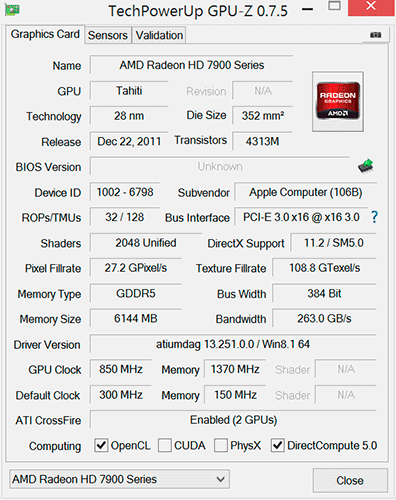
The model numbers are unique to Apple. FirePro D300, D500 and D700 are the only three options available on the new Mac Pro. The D300 is Pitcairn based, D500 appears to use a Tahiti LE with a wider 384-bit memory bus while D700 is a full blown Tahiti XT. I’ve tossed the specs into the table below:
| Mac Pro (Late 2013) GPU Options | ||||||
| AMD FirePro D300 | AMD FirePro D500 | AMD FirePro D700 | ||||
| SPs | 1280 | 1536 | 2048 | |||
| GPU Clock (base) | 800MHz | 650MHz | 650MHz | |||
| GPU Clock (boost) | 850MHz | 725MHz | 850MHz | |||
| Single Precision GFLOPS | 2176 GFLOPS | 2227 GFLOPS | 3481 GFLOPS | |||
| Double Precision GFLOPS | 136 GFLOPS | 556.8 GFLOPS | 870.4 GFLOPS | |||
| Texture Units | 80 | 96 | 128 | |||
| ROPs | 32 | 32 | 32 | |||
| Transistor Count | 2.8 Billion | 4.3 Billion | 4.3 Billion | |||
| Memory Interface | 256-bit GDDR5 | 384-bit GDDR5 | 384-bit GDDR5 | |||
| Memory Datarate | 5080MHz | 5080MHz | 5480MHz | |||
| Peak GPU Memory Bandwidth | 160 GB/s | 240 GB/s | 264 GB/s | |||
| GPU Memory | 2GB | 3GB | 6GB | |||
| Apple Upgrade Cost (Base Config) | - | +$400 | +$1000 | |||
| Apple Upgrade Cost (High End Config) | - | - | +$600 | |||
Despite the FirePro brand, these GPUs have at least some features in common with their desktop Radeon counterparts. FirePro GPUs ship with ECC memory, however in the case of the FirePro D300/D500/D700, ECC isn’t enabled on the GPU memories. Similarly, CrossFire X isn’t supported by FirePro (instead you get CrossFire Pro) but in the case of the Dx00 cards you do get CrossFire X support under Windows.
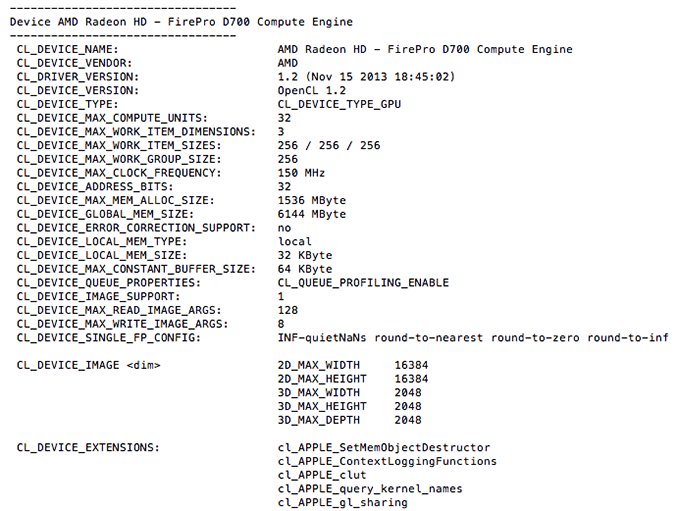
Each GPU gets a full PCIe 3.0 x16 interface to the Xeon CPU via a custom high density connector and flex cable on the bottom of each GPU card in the Mac Pro. I believe Apple also integrated CrossFire X bridge support over this cable.
With two GPUs standard in every Mac Pro configuration, there’s obviously OS support for the configuration. Under Windows, that amounts to basic CrossFire X support. Apple’s Boot Camp drivers ship with CFX support, and you can download the latest Catalyst drivers directly from AMD and enable CFX under Windows as well. I did the latter and found that despite the option being there I couldn’t actually disable CrossFire X under Windows. Disabling CFX would drop power consumption, but I didn't always see a corresponding decrease in performance.
Under OS X the situation is a bit more complicated. There is no system-wide CrossFire X equivalent that will automatically split up rendering tasks across both GPUs. By default, one GPU is setup for display duties while the other is used exclusively for GPU compute workloads. GPUs are notoriously bad at context switching, which can severely limit compute performance if the GPU also has to deal with the rendering workloads associated with display in a modern OS. NVIDIA sought to address a similar problem with their Maximus technology, combining Quadro and Tesla cards into a single system for display and compute.
Due to the nature of the default GPU division under OS X, all games by default will only use a single GPU. It is up to the game developer to recognize and split rendering across both GPUs, which no one is doing at present. Unfortunately firing up two instances of a 3D workload won’t load balance across the two GPUs by default. I ran Unigine Heaven and Valley benchmarks in parallel, unfortunately both were scheduled on the display GPU leaving the compute GPU completely idle.
The same is true for professional applications. By default you will see only one GPU used for compute workloads. Just like the gaming example however, applications may be written to spread compute workloads out across both GPUs if they need the horsepower. The latest update to Final Cut Pro (10.1) is one example of an app that has been specifically written to take advantage of both GPUs in compute tasks.
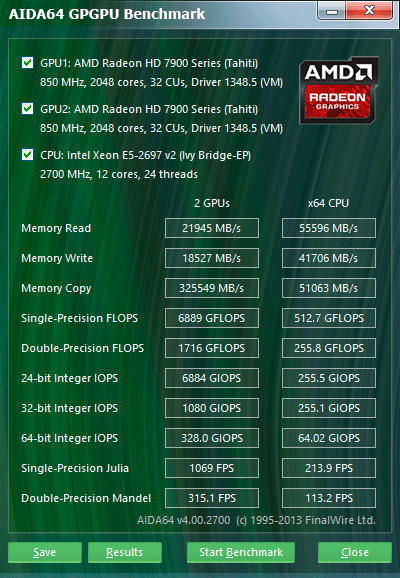
The question of which GPU to choose is a difficult one. There are substantial differences in performance between all of the options. The D700 for example offers 75% more single precision compute than the D300 and 56% more than the D500. All of the GPUs have the same number of render backends however, so all of them should be equally capable of driving a 4K display. In many professional apps, the bigger driver for the higher end GPU options will likely be the larger VRAM configurations.
![]()
I was particularly surprised by how much video memory Final Cut Pro appeared to take up on the primary (non-compute) GPU. I measured over 3GB of video memory usage while on a 1080p display, editing 4K content. The D700 is the only configuration Apple offers with more than 3GB of video memory. I’m not exactly sure how the experience would degrade if you had less, but throwing more VRAM at the problem doesn’t seem to be a bad idea. The compute GPU’s memory usage is very limited (obviously) until the GPU is actually in use. OS X reported ~8GB of usage when idle, which I can only assume is a bug and a backwards way of saying that none of the memory was in use. Under a GPU compute load (effects rendering in FCP), I saw around 2GB of memory usage on the compute GPU.
Since Final Cut Pro 10.1 appears to be a flagship app for the Mac Pro’s CPU + GPU configuration, I did some poking around to see how the three separate processors are used in the application. Basic rendering still happens on the CPU. With 4K content and the right effects I see 20 - 21 threads in use, maxing out nearly all available cores and threads. I still believe the 8-core version may be a slightly better choice if you're concerned about cost, but that's a guess on my part since I don't have a ton of 4K FCP 10.1 projects to profile. The obvious benefit to the 12-core version is you get more performance when the workload allows it, and when it doesn't you get a more responsive system.
Live preview of content that has yet to be rendered is also CPU bound. I don’t see substantial GPU compute use here, and the same is actually true for the CPU. Scrubbing through and playing back non-rendered content seems to use between 1 - 3 CPU cores. Even if you apply video effects to the project, prior to rendering this ends up being a predominantly CPU workload with the non-compute (display) GPU spending some cycles.
It’s when you actually go to render visual effects that the compute GPU kicks in. Video rendering/transcoding, as I mentioned earlier, is still a CPU bound affair but all effects rendering takes place on the GPUs. The GPU workload increases depending on the number of effects layered upon one another. Effects rendering appears to be spread over both GPUs, with the compute GPU taking the brunt of the workload in some cases and in others the two appear more balanced.
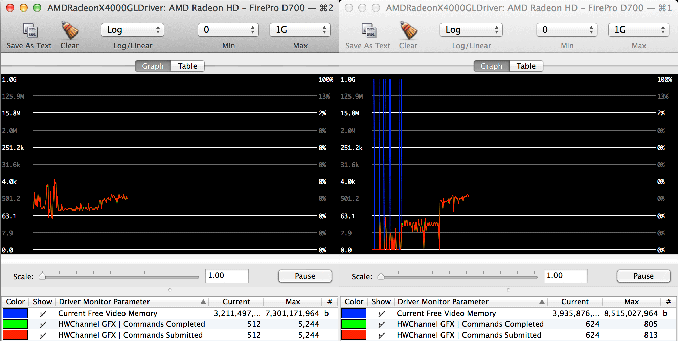
GPU load while running my 4K CPU+GPU FCP 10.1 workload
Final Cut Pro’s division of labor between CPU and GPUs exemplifies what you’ll need to see happen across the board if you want big performance gains going forward. If you’re not bound by storage performance and want more than double digit increases in performance, your applications will have to take advantage of GPU computing to get significant speedups. There are some exceptions (e.g. leveraging AVX hardware in the CPU cores), but for the most part this heterogeneous approach is what needs to happen. What we’ve seen from FCP shows us that the solution won’t come in the form of CPU performance no longer mattering and GPU performance being all we care about. A huge portion of my workflow in Final Cut Pro is still CPU bound, the GPU is used to accelerate certain components within the application. You need the best of both to build good, high performance systems going forward.


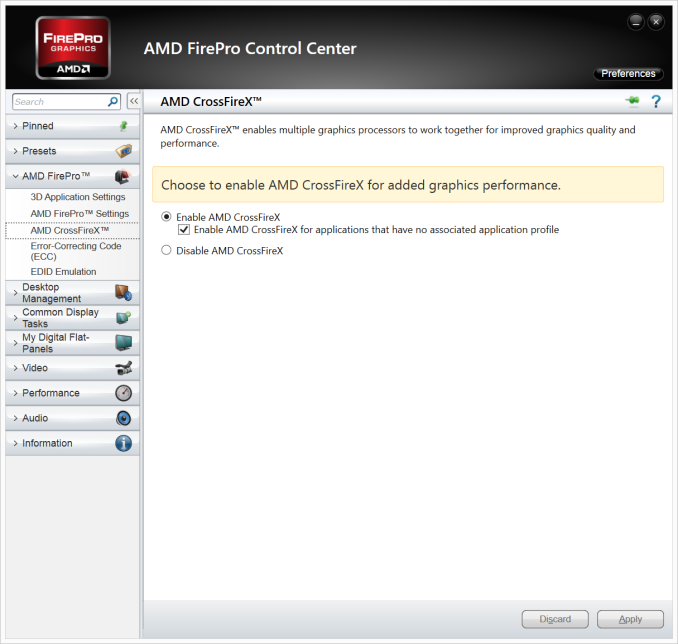
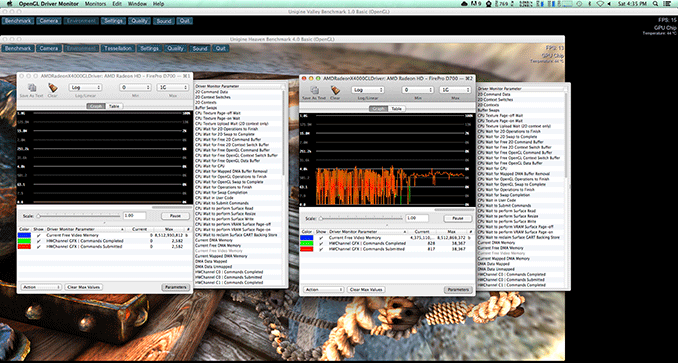








267 Comments
View All Comments
wallysb01 - Friday, January 3, 2014 - link
Actually, you can upgrade the CPU. What you can’t do is replace the monitor.Liquidmark - Friday, January 3, 2014 - link
You can attach external monitors to the iMac.Liquidmark - Friday, January 3, 2014 - link
"The problem with saying Apple's pricing isn't out of touch with reality is that you can't only compare this to high end workstation's from other companies..."This is a workstation. It has workstation components and is formally classified as such, so you kinda have to compare it to *gasp* OTHER workstations and match their spec as closely as possible to see if the price of the Mac Pro is reasonable or not. Anand is absolutely correct in comparing this to a HP Z420 which is HP's mid-range workstation right now.
"this is Apple's only desktop-ish device."
Ever heard of the Mac Mini?
"Apple doesn't provide options for people who want a high end notebook or desktop for normal use.."
Ever heard of the Macbook Pro or iMac?
You can't discount the fact that the Mac Pro has Xeons under the hood just because you don't like the other options Apple offers. If the Mac Pro has Xeons under the hood, then you have to factor that into the price of the device. You don't get to ignore the engine in a Bently to claim that a Bently is thus overpriced when compared to a Toyota Corolla. You don't get to say that it should have an engine from a Toyota Corolla and that theuy shouldn't have the luxury features and hand-crafted attention to detail that come with a bently. If you want a Toyota corolla, go buy a Toyota Corolla. If you want a Dodge viper, go buy that. Don't tell Bently to make a Toyota Corolla or a Dodge viper and don't expect to buy a bently at the cost of a toyota corolla or dodge viper either because you seem to dismiss the facts that there are differences between the three.
"it's at least 2x as expensive as it should be for it's base unit"
Not according to actual price comparisons it isn't..
Bobs_Your_Uncle - Thursday, January 2, 2014 - link
I'm still wondering how that Nokia Lumia 1020 review is coming along !?p51mustang6 - Thursday, January 2, 2014 - link
You should really do research, just a little, prior to making a review like this, you make a bold statement saying how the Mac Pro is so great and for so cheap, yet you compared it to two companies far from known for making anything professional. Try comparing the Mac Pro to The Origin Genesis Pro-X2 from Origin PC. It starts out with considerably higher specs with a LOWER price tag. They also offer up to dual Intel Xeon E5-2697 Dodeca-core processors (that's 12 cores each CPU for those of you who couldn't handle that) for a total of 24 cores (or twice that of the Mac Pro), up to dual 12GB NVIDIA Quadro K6000s (Apple doesn't even offer anything even closely comparable lol), up to 256GB of RAM (Apple offers up to 64GB), up to 4TB of SSD storage (compared to Apple's 1TB, granted PCI), comes standard with liquid cooling (Apple does not offer), up to an additional 12GB NVIDIA Tesla K40 (once again Apple offers nothing of the sort), Origin comes with one year warranty upgradable to 3 years but also comes standard with LIFETIME support with 24/7 United States based support (I wonder where Apple's support that you get 90 days of is based...lol) The starting price of the Origin is $3,712 compared to $3,999 of the Mac Pro which does not come with dual processors. The trash can is a complete rip off which requires you to go out and use their thunderbolt ports in order to do any real upgrading so you will have random things sitting on your desk, the Origin perhaps bigger, but at least all the goods will always be inside of it. Instead of spending all their time trying to make a computer a cylinder maybe Apple should have tried to compete with the real heavy hitters such as Origin PC.Louiek - Thursday, January 2, 2014 - link
Hi, I am currently myself trying to compare a maxed out mac pro ~ $10k CAD with other OEM workstations of similar spec. I looked into origin but I can't seem to build a similar spec'd (i.e. single Xeon E5-2697v2 etc) that will cost under $11k CAD. Is there something I am missing as your comment leads me to believe that I can build a cheaper PC with origins with similar specs.Liquidmark - Friday, January 3, 2014 - link
You can't the Origin machine only offers extreeeeme options that are ideal for gaming with neon lights. Its solution to things is to throw more cores at it and throw more ram at it even though the ram is slower...stingerman - Thursday, January 2, 2014 - link
Sorry dude, triedto configure a comparable system and it costs more than the Mac Pro...Liquidmark - Friday, January 3, 2014 - link
Ok, I'll bite...Mac Pro:
2.7GHz 12-core with 30MB of L3 cache
32GB (4x8GB) of 1866MHz DDR3 ECC
256GB PCIe-based flash storage
Dual AMD FirePro D700 GPUs with 6GB of GDDR5 VRAM each
User's Guide (English)
$8000 and weighs roughly 11 pounds
GENESIS Pro-X2
ASUS Z9PE-D8 WS
Dual ORIGIN FROSTBYTE 120 Sealed Liquid Cooling Systems
Dual Intel XEON E5-2630 v2 Hex-Core 2.6GHz (3.1GHz Turbo) 15MB Cache (That's 12 cores at a lower clock than the Mac Pro build)
1000 Watt Corsair RM1000
Dual 6GB NVIDIA Quadro 6000 (Non-SLI)
32GB Kingston ECC 1600MHz (4x8GB)
Genuine MS Windows 7 Professional 64-Bit Edition
250GB Samsung 840 Evo Series
ASUS 24X CD/DVD Burner
On Board Audio
Onboard Network Port
ORIGIN Wooden Crate Armor
1 Year Part Replacement and 45 Day Free Shipping Warranty with Lifetime Labor/24-7 Support
ORIGIN Recovery USB3.0 Flash Drive
ORIGIN PC G8 T-Shirt XL
Microsoft Internet Explorer
$11,017 and weighs over 70 pounds.
Now, before anyone says anything, the tee shirt was free and the water cooling was the only offer plus they give a free games offer that I didn't take. Tho I probably should since apparently workstations are all about pro gaming, neon lights and being extreeeeeme.
Liquidmark - Friday, January 3, 2014 - link
Also, if anyone wants to argue that you can get dual 12-core on the origin machine, I'll simply point out that, at spec, I'd almost be able to buy two 12 core Mac Pros. Just saying.